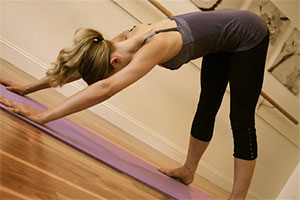
OUR APPROACH
We believe every individual, regardless of fitness level, provided they are equipped with the proper knowledge and guidance by a professional instructor, is capable of enjoying and benefiting from the practice of Yoga.
We often hear complaints that yoga classes are overcrowded, and instructors pay little or no individual attention to their clients, particularly when form is involved. In our opinion, such practice only allows for limited growth and potentially subjects the body to unnecessary injuries.

BOUTIQUE CLASSES
Our classes are small, – 8 people at most, – and our teachers focus on biomechanics of the body in motion. Instructors help clients realign their myoskeletal system to eliminate any torques and strains they have. Yoga is an evolving practice, and we strongly believe our smaller class size will result in greater access to our experienced instructors. This will greatly enhance your experience and maximize your time on the mat.
- We believe it is of outmost importance to connect the mind to the body when practicing any strength building exercises.
- Awareness of the body’s tensegrity,- moving it through space as one succinct unit, – requires us to be present and aware of each segment of the myoskeletal system as well as the segmental correlations.
- Showing up on the mat ready to learn something new each time, rather than going through the motions, makes for a smarter practice. This approach can be more easily achieved with smaller class sizes and greater individual attention.
NAMASTE
For Frequently Asked Questions About Yoga and Meditation, click here
YOGA & MEDITATION BENEFITS
Long-term yoga practitioners have reported musculoskeletal and mental health improvements, as well as reduced symptoms of asthma in asthmatics. Regular yoga practice has been shown to improve mood and anxiety more than some other metabolically matched exercises, such as walking. Overall, studies of the effects of yoga on heart disease suggest that yoga may reduce high blood pressure, improve symptoms of heart failure, enhance cardiac rehabilitation, and lower cardiovascular risk factors. Yoga is used for treatment of cancer patients to decrease depression, insomnia, pain, and fatigue and increase anxiety control.
In short, yoga is a disciplined method utilized for attaining a goal. The physical postures of yoga are used to alleviate health problems, reduce stress and increase suppleness of the spine. Yoga is used as a complete exercise program for the mind, body and soul.
Physiological Benefits of Yoga & Meditation
- Stabilizes autonomic nervous system and strengthens equilibrium
- Decreases blood pressure, pulse & respiratory rate
- Increases immunity, cardiovascular & respiratory efficiency
- Normalizes Endocrine & gastrointestinal function
- Excretory functions improve
- Increases myoskeletal flexibility, joint range of motion , & grip strength
- Improves posture, eye-hand coordination, dexterity skills, reaction time & steadiness
- Increases strength, resiliency, endurance & energy levels
- Normalizes weight
- Improves sleep
Psychological Benefits of Yoga & Meditation
- Increases somatic and kinesthetic awareness
- Improves mood, memory, attention & concentration
- Increases self-acceptance, self-actualization, & social adjustment
- Decreases anxiety, depression, & hostility
Biochemical Benefits of Yoga & Meditation
- Decreases Total white blood cell count, Glucose, Sodium Triglycerides, LDL & VLDL cholesterol, Catecholamines,& Total cholesterol
- Increases HDL cholesterol, Cholinesterase, ATPase, Hematocrit, Hemoglobin, Thyroxin, & Total
serum protein
Yoga Health Benefits
- Subcortical regions of brain & Parasympathetic Nervous System dominate
- Slow dynamic & static movements
- Normalization of muscle tone
- Low risk of injuring muscles and ligaments
- Energizing (breathing is natural or controlled)
- Balanced activity of opposing muscle groups
- Noncompetitive, process-oriented


